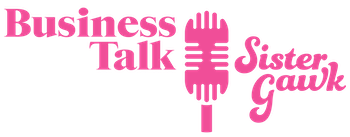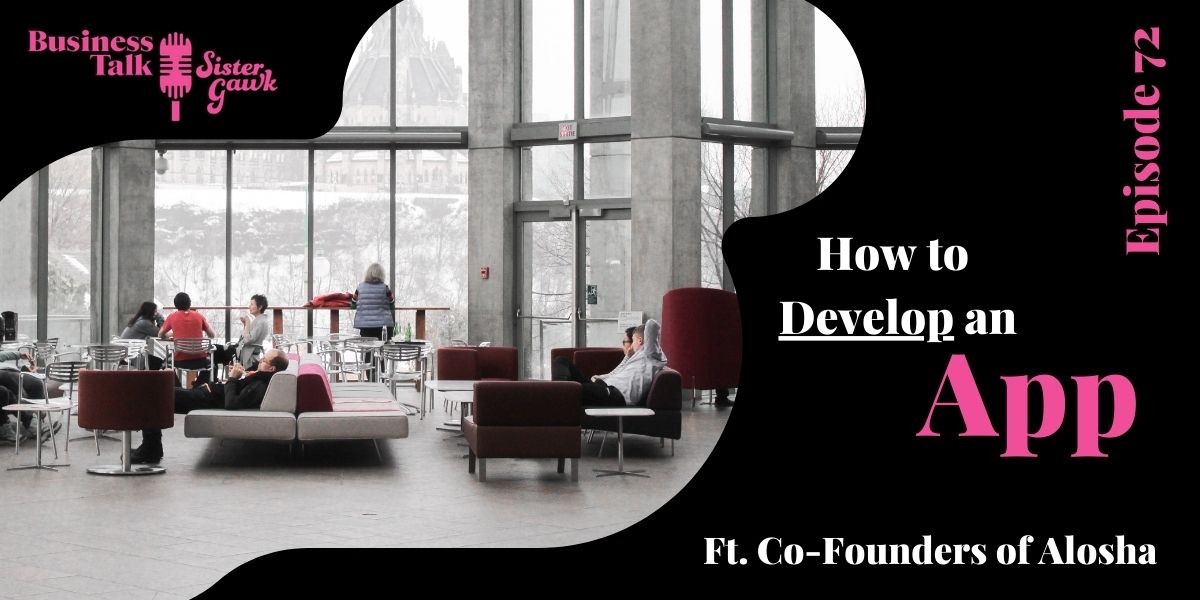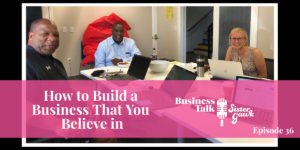Have you ever wondered how people get into the app store? This week we hear from the founders of Alosha, an artist e-commerce app, about how developing an app works. This is a great listen for anyone who’s looking to get more into app development and are curious where to get started. Some of the best resource recommendations are in our last question, so stick around till the end!
Welcome to Business Talk Sister Gawk! I’m Bekkah! And I’m Ruthie and today’s episode title is “How to Develop an App” and with us today we have Mark Hartman and Tariq and I did not grab your last name so could you tell us what it is?
Tariq: Oh, right! No worries at all. Most people don’t. It’s Elkibalan.
Bekkah: Alright!
Tariq: Yeah, Elkibalan.
Bekkah: I’m kind of thankful I didn’t have that in my notes.
Tariq: Yeah it’s not – I know like it’s kind of, if this is a word “sybillic” you know? It just kind of sounds exactly how it’s parsed out, but it’s like when you first see it you know you panic. I remember it was a headache for me as a kid learning how to how to spell that last name.
Bekkah: Yeah, alright well, thank you guys for being with us today we are excited to have you!
Tariq: Alright, thank you, thank you!
Bekkah: Our first question for you guys today is what do you do?
Tariq: Okay, alright, so as of myself I’m the CTO of Alosha and I typically handle for the most part a lot of the technical implementation aspects of the app and website as well. I think most of Alosha, if not all of it, was is coded and software by me. I do a lot of the UI design for the app as well. With a couple of kind of outsourcing things here and there. At the end of the day, at my core I am an engineer so some of the more design-ish type things like illustrations and things like that a lot of gradients I kind of struggle with but for the most part I do a lot of the UI design for our branding across the platform.
What Is OI and UI Design?
Ruthie: Okay, so you said a couple different things there. You said like the Alosha, which I’d love for you to explain and then I think you said that was it the OI design?
Tariq: Oh, I’m sorry UI!
Ruthie: UI! I’m sorry, my bad! Could you explain those?
Tariq: Yes! So, yes, Alosha it’s a music platform that Mark and I co-founded I think about a couple years ago to basically help aspiring artists kind of get out there. You know, sell their artwork, their music, their paintings, their sculptures, in order to earn a profit during the early days of their careers we saw the potential to help these young and inspiring artists – new artists for the most part. Because a lot of the galleries and other places they take a significant cut maybe some I think was it 50% cut/commission on the artwork.
At least with Alosha you know we only take 25% commission on the artwork that’s sold and we only get paid when the artists get paid. We wanted to be able to build a platform for artists to help get them started in their art career. So that’s what Alosha is and that’s the business that Mark and I have started. Now on the topic of UI design that right there is UI is user interface and it’s basically creating the layouts for any type of – technically, it really is any type of interface you interact with! Any other type of system.
You could even consider your car dashboard a user interface system, but in this case within Alosha I designed the user interface of the app. The buttons you press, you know tap this button, you go to this screen, you go to that screen. I set the colors and things like that. Basically, it’s user interface design. It is art but it’s a little bit more of like art in motion so to speak and people – how do you use this picture to get done what you want to get done? You know, that’s user interface design, UI Design.
What Did You Get Into App Development on This Project?
Ruthie: Yeah, so it’s kind of like practical, technological art which is really cool! Okay, so tell us about your why. You touched a little bit on like that you wanted to have something different than like a gallery for artists, but what was your why behind getting started with this and Mark if you want to jump in on this too you definitely can.
Tariq: Okay, I mean because they originally got started working on it a couple of years ago and it was a contract that Mark wanted to basically build it. He brought me onto the business partner to get it rolling in the initial launch of the product and then, later on, I kind of seen a little bit of the viability of it from a business perspective.
I joined on as a co-founder basically having equity in the business and just contributing my technical expertise. Now Mark himself is actually he’s actually an artist full-blown artist. I’m a little bit more on the technical side so Mark would definitely be able to kind of go into a lot more details on what really drives the artist and a lot of the needs he sees that Alosha basically bridging. The gaps that he sees Alosha is bridging for a lot of these aspiring artists.
Ruthie: Yeah, so, Mark, go ahead and jump in and tell us a little bit about that.
Mark: Absolutely, the main reason why we have created this application is for that struggling musician, right? When I was a musician or I still am completely, full-blown, I was spending so much money on trying to get my music out into the world and well, I was getting nothing back. When creative people, for instance, when they put out all the artwork and they create a video and or they create music, they don’t get anything in return. They keep spending money on equipment. They keep spending money on paints, canvases, and things of that nature but they get nothing in return. My main mission was why don’t we give something to them?
How to Start Building an App
Bekkah: How did you go about building the concept design for the app? I know some people would call for a website – I’ve heard of it as like a wireframe. How did you go about saying this is what needs to go where and how do all these pieces fit together?
Mark: Well, I got it from different applications. For instance, Soundcloud, Spotify, and YouTube iTunes, and everything like that. They all charge subscriptions. I didn’t want subscriptions in the beginning. What I wanted to do was charge a commission fee. It’s not 25%. It’s 15% and I want to make the artist the most vocal out there. Nothing about us just the artist, him or herself vocally, and the concept was when I was dreaming about the opportunity that I would want in the world, that I would want, at first it started selfishly. It was all for me and then I was like, “There are so many people who could benefit from this instead of just benefiting myself.”
Ruthie: Yeah, okay, so maybe getting more into like the technical piece of it because I think that that’s really cool like how you were talking about how it relates to iTunes and things like that and how you were kind of seeing Spotify and the comparison there. How did you maybe this would be more of a question for Tariq, how did you get into what kind of programming languages are necessary to be an app developer?
Tariq: I guess, in my case, it was a little bit more of with the language I decided to roll with and the framework that I used to develop the app. I looked at the landscape and I did look a little bit at what was currently available for what would work well for Alosha. A couple of things you have to take into consideration is the kind of your user audience, the type of features you’re trying to implement, and your time to product launch.
There’s this concept in app development where we have native apps and we also have hybrid apps. A native app is like an app that is specifically, tailor-made for just say your iPhone. It only works on iOS. Basically, the iPhone or it only works on Android. Not both, it just only works on Android. Now that’s great if your app is feature-rich it uses a lot of things like location services, the health kit on iOS, and I think Google has something similar over on Android. It’s escaping me right now and other types of really device-specific features.
That’s where native app development shines, but it’s unfortunate with that because you then have to go and develop the app twice. We saw with Alosha that a lot of the features are kind of more standard. It wasn’t necessarily feature rich. We weren’t asking for people’s locations, their contacts, their health information, all they’re really doing is uploading images of their artwork or you know audio files and just displaying it and creating a marketplace for artists that basically highlights their content.
With this, the requirements being like that I was like, “Well, let’s go ahead and create a hybrid app. It won’t give us a lot of that super, high-powered features that you would get with the native app, but we would only have to write the app just once and then we would be able to launch it on Android and on the iOS stores.” Then that basically cuts your development time in half really having to do that and also greatly reduces your maintenance as far as keeping the apps up.
What is The Difference Developing For iOS Versus Android?
Bekkah: Yeah, and that was totally the question I had because I was like, “Well, I know a lot of people only develop for one. Either iOS or Android and then they don’t do the other right away so I guess my question with that is, are there major differences between the process in getting into the app store and all that kind of stuff? Did you have to watch a bunch of YouTube videos or did you already know how to do this and what are key things that someone should know if they wanted to try to get an app out there?
Tariq: Ah, yes, you know I’m really a software engineer by trade. I’m actually a freelance app developer. I work with companies to develop apps and get them to market and things like that. I actually had a background in the field and I had actually gone to school like college you know for software, computer engineering specifically, but I’ve worked with in my time a lot of people that are kind of self-made software engineers. They were just a guy or gal that just started watching YouTube videos, looking around on websites like Github for open source projects to consider and to contribute to.
They slowly but surely built up a rather impressive resume and they’re doing very well for themselves right now. Although, that isn’t exactly it is kind of – it’s the steeper road to go, because you know a lot of people get really stuck on the whole degree thin, but really if you go that road – the self-taught approach – you can really do pretty well for yourself once you kind of get your foot in the door with someone that you can kind of put on your portfolio as far as your app goes. But, yeah.
What Are The Hardest Parts of App Development?
Ruthie: Okay, so what are some of the hardest parts about development and how do you get yourself unstuck if you’re in a place where you’re like, “I don’t know how to move forward”?
Tariq: Right, right, I guess the hardest part about development at least as a software engineer is you know us engineers we can oftentimes – I guess they’re really like anybody. You get excited about new projects or new possibilities and during those initial phases of being all kind of juiced up and excited about launching an app you have to make sure you pump the brakes heavy. You pause and you make sure you kind of properly scope out the architecture of the software application.
With that said, say, you know with Alosha, one of the things this was like a little bit earlier on during our process, and I’ll try to kind of speak through our experience developing Alosha was I didn’t really architect as well as I could have in the initial launch of Alosha. The layout for how the app – the codebase within the app would be organized. Because when you really, you know it’s kind of a little bit, you can’t really just compare app development to like say building a house because houses are pretty standard and custom. Software is very custom, but if you have a really well-thought-out architecture it removes a lot of the variables for you when you actually get ready to go.
You just have to make sure you don’t get too excited and you just go willy-nilly going crazy at your keyboard just hacking away. That was one of the things that I know we learned or specifically I learned was a big one just make sure before you start working on that app you have a pretty good plan from your technical side and also from the business side as well and making sure you’ve properly scoped out your I guess I’ll call them sales funnels. But I think our use case might be called something a little bit different with the whole two-sided market approach we’ve got.
Make sure you’ve kind of already got your sales funnels. Like, “Okay, how frequently are you going to send off a push notification to remind people to upload their artwork? What type of blog posts are you going to accompany with your app to kind of demonstrate how you can actually help people? How are you going to educate people on how your app’s going to help their new and inspiring artist career?
One of the things I think I know because I’m an engineer that I personally have kind of come up – things you learn as you go in business is especially in a startup you have to spend half your time in marketing and then the other half in development. If you’re someone like me you’re more of a developer type well, you know the saying “to the hammer everything looks like a nail”? Well, that’s not a problem with getting the message out! I just need to add a new feature because, well I’m just going with the hammer and that’s just what I like to use. You have to be very balanced with it. Yeah.
Is There A Certain Amount of Readiness You Need Before Launching Your App?
Ruthie: Yeah, so I kind of get this picture of you like a kid on Christmas Day ripping open presents and then just off to the races like so excited about whatever you’re doing! I love that you said like you just kind of have to have that all prepared and kind of have an idea of what you’re doing and what you’re working towards. A question to tie into that is when you are talking about like the actual launching of the app, can you launch an app that’s still under development and then kind of tweak it along the way or is there a specific level of readiness that it has to pass before you can actually move forward with the launch?
Tariq: Ah, yes, yeah so technically when you launch an app it is really still in development. Maybe a lot of people sometimes developers might not want to admit this but you don’t truly know your app works until it hits production. When we say “production” that means it’s live in the app store. It’s in people’s hands and we’re getting a good handle on what type of errors are getting thrown and why aren’t people being able to get to certain pages in the app? That’s really the biggest thing about launching it.
I know any other app developer will tell you this. It’s always easier to get the app into the Android store than it is the Apple store. Apple is really persnickety about launching apps in their app stores. There are all types of extra requirements you have to jump through in order to get it through the process, but really one of the things in more recent times that I’ve started to do and anybody listening to this podcast that probably would help them is to see if the earlier in the phase you can try to make an attempt to put your app in the app store the better.
I know it usually takes maybe for Apple it might take about two weeks to get into the app store. I know recently I had a little bit of a scare with the app store when I developed an app for someone and Apple was claiming that the subscription feature that we had didn’t count as a subscription. Now as it would turn now Apple was incorrect and I had to send a summary email explaining how the subscription qualifies to be classified as an in-app subscription, but for a split second, I was sitting there panicked like, “Oh my god. I have built an app that doesn’t qualify for subscription services!!”
Meanwhile, you know the Google Play store had already accepted the app and it was live and everything but I was like really sweating bullets over on the iOS side of things trying to push it through to his app store, but that’s probably one of the best advice I can kind of come up with for your listeners is the sooner you can – even if the app isn’t air quote “done”. Throwing up my air quotes here. The sooner you can get it published to the app store the better and then you can just have updates week after week after that to just get it through. Maybe not market it so much during those initial phases before it’s truly done, but just get into the app store basically as early as possible. Then market the app once it’s actually fully deployed and all the features are developed.
Ruthie: That is so good.
What Happens When The App Store Changes Requirements?
Bekkah: Oh! My other question was what – because I’ve heard this from somebody else that we interviewed they said, “I used to be in app development and then I got out of it because it was so much risk.” I was thinking about that like okay so that’s my question for you, what happens if an app store changes a requirement and what does that do to your app?
Tariq: Right, well, it’ll kill you. *all laugh* It’s what it’ll do.
Ruthie: Yikes!
Tariq: Yeah, yeah it will. I have been fortunate to not have an app killed like that, but it is something that yeah you are rolling the dice. It is actually, because of the nature of the app stores and you’re really just at the mercy of Google and Apple and how they feel about you and your app.
Ruthie: Isn’t that the truth! Oh, man!
Tariq: Yeah it really is! You know, it’s one of the app development services that you do. It is a lot riskier than say web development because web everything’s open. You know anybody can get a web server and just spin up whatever they want, grab a domain, and just go about their business, now when you’re on Apple and Google’s Play store you’re really subject to their rules their laws, and everything. Say like in my case, the risk I almost had a near disaster on this project with the app with the in-app subscriptions. Finding out, I was able to talk my way out of that one but sometimes I’ve heard stories of people who weren’t able to. And Apple was just stuck in their ways and they didn’t want to see it any other way. You know so it is risky and you know sometimes I’ve had to tell people that I wouldn’t take on a project. I’ve turned down projects because the risk was too much involved because I felt that the permissions that the app was asking for were a little bit too pervasive. I had just a good feeling. Google probably Android probably would have been okay with it on their store but Apple I’m almost certain would have shut that down. Yeah, almost certain they would have.
Ruthie: Okay, well we’re kind of getting close to time here I thought of a pun while you were talking and I just wanted to say it I was thinking. “I guess you kind of have to play by their rules!” Get it?
Tariq: Yeah, pretty much!
Ruthie: Because Google Play! Get it?
Tariq: Google Play!
Ruthie: Ok.
Bekkah: That was so bad.
Ruthie: Thank you, thank you.
Bekkah: You should not even have laughed.
Tariq: It’s cool, you know it’s funny because I guess how corny it is! It’s just yeah.
Ruthie: It’s like when you have to jump through all their hoops you either laugh or you cry so you know –
Tariq: It’s a choice! It’s a choice! And I choose to laugh at all of the hoops that I’ve had to jump through with the app stores through the years. It’s been fun. It’s a good challenge. I like challenges! It’s definitely an uphill road and it’s always really good to – you feel really good about – say with Alosha and the UI design the effort I put in, you feel really good kind of giving birth to an idea when you publish it on the app store for people of the world to use. It feels good.
Resources You Should Use to Get Into App Development
Ruthie: Absolutely! Okay, it’s been so cool to learn from you and I know you have I was just thinking the whole time was like, “Man, this guy is so smart and he has just been through so much experience!” I don’t know it’s just cool to hear from you so give us some tools and resources that like anybody who wanted to start app development or something like what was really helpful for you and what websites or YouTube videos or podcasts even what was helpful for you?
Tariq: Okay, yes, my preferred toolbox for app development is this framework basically built by Google called Flutter. It’s a hybrid framework. It’s stable. It’s really popular and a lot of other people use it. It has a nice community built around it but that’s what I know for the most part, but there are other hybrid frameworks out there. I think as a general crux to get started, I would suggest users probably get started building native Android apps and then from there potentially transition into a hybrid app platform.
Basically, that would mean that you would be building an Android app in either Java, that’s a programming language, or Kotlin and you can find an incredible wealth of YouTube videos online. No specific channels in particular that I have in mind because there are just so many just really rock star developers out there just uploading YouTube videos at a rapid clip. Just start there and become really strong on one platform and then from there start to acquire the skills to understand a hybrid platform. A hybrid platform really lets you build for not just Android but also for iOS.
It gives you that toolbox to be able to sell your services to people that need both apps and then from there it’s just a matter of you know you’ll have to watch a lot of YouTube videos. It’ll be very frustrating during those early stages and if you like, there are a lot of kind of software developer schools as opposed to say someone like me you go to a four-year university when technically to do what I do now I probably only needed about a year or two.
There are like programs that are like that. That actually will teach you how to do app development for Android or iOS or maybe both and kind of give you school the skills necessary and send you off into the world. There are various ones. None of them are really coming to me off top of my mind, but that’s like one of the quickest ways to kind of get into the app development game is just that. If you’re going to do whether it’s self-taught which you know following the whole YouTube videos and just playing around. You have an idea and you just want to get in there and tinker.
You know, that’s the biggest thing about getting into app development. It’s very specific. The process, you have to be very detail-oriented but as long as you’re having fun you can do it. You just have to have fun. That’s the catch! It’s gonna be very frustrating at times but just figure out whatever it is however you figure out how to do it! Just make sure you’re having fun and you can do it. You can actually do it.
Bekkah: Okay, well, we’re going to transition into our gawk portion! Thank you so much for giving us those resources. I’ve never even heard of Flutter so I’m excited about that!
If you liked this podcast, follow us on Instagram and hear about all our updates!




